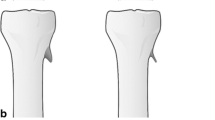Abstract
Spontaneous regression of an osteochondroma is an infrequent event. In this report, two cases with spontaneous regression of osteochondromas are presented. The first case was a solitary osteochondroma of the pedunculated type involving the right proximal humerus in a 7-year-old boy. This lesion resolved over 15 months of observation. The second case was a 3-year-old girl with multiple osteochondromatosis, in whom sessile osteochondromas of the right tibia and left fibula regressed over 33 months.The mechanism of this phenomenon is discussed with a review of previous reports. Regarding treatment, careful observation may be acceptable for typical osteochondromas, especially in young children.





Similar content being viewed by others
References
Khurana J, Abdul-Kari F, Bovey JVMG. Osteochondroma. In: Flecher CDM, Unni KK, Mertens F, editors. World Health Organization classification of tumors: pathology and genetics; tumors of soft tissue and bone. Lyon: International Agency for Research on Cancer; 2002. p. 234–6.
Unni KK. Osteochondroma. In: Unni KK, editor. Dahlin’s bone tumors: general aspects and data on 11,087 cases. 5th edn. Philadelphia: Lippincott-Raven; 1996. p. 11–23.
Hunter J. The works of John Hunter, with notes by JF Palmer. London: Longmans; 1835. p. 533–4.
Yamamoto T, Kurosaka M, Misuno K. Spontaneous resolution of a phalangeal solitary osteochondroma. J Hand Surg 2001;26:556–8.
Callan JE, Wood VE, Linda L. Spontaneous resolution of an osteochondroma. J Bone Joint Surg (Am) 1975;57:723.
Choi JY, Hong SH, Kim HS, Chang CB, Lee YJ, Kang HS. Resorption of osteochondroma by accompanying psedoaneurysm. AJR 2005;185:394–6.
Reston SC, Savva N, Richards RH. Spontaneous resolution of solitary osteochondroma in the young adult. Skeletal Radiol 2004;33:303–5.
Porter DE, Simpson AH. The neoplastic pathogenesis of solitary and multiple osteochondroma. J Pathol 1999;188:119–25.
Milgram JW. The origins of osteochondromas and enchondromas. A histopathological study. Clin Orthop 1988;264–84.
Cleikens B, Brays, Samson I, Bart AL. Spontaneous resolution of a solitary osteochondroma. Skeletal Radiol 1998;27:53–5.
Copeland MR, Meehan PL, Morrissey RT. Spontaneous regression of osteochondromas; two case reports. J Bone Joint Surg (Am) 1985;67:971–3.
Castriota-Scanderbeg A, Bonetti MG, Cammisa M, Dallapiccola B. Spontaneous regression of exostoses: two case reports. Pedatr Radiol 1995;25:544–8.
Parling MR. The “disappearing” osteochondroma. Skeletal Radiol 1983;10:40–2.
Author information
Authors and Affiliations
Corresponding author
Rights and permissions
About this article
Cite this article
Hoshi, M., Takami, M., Hashimoto, R. et al. Spontaneous regression of osteochondromas. Skeletal Radiol 36, 531–534 (2007). https://doi.org/10.1007/s00256-006-0235-9
Received:
Revised:
Accepted:
Published:
Issue Date:
DOI: https://doi.org/10.1007/s00256-006-0235-9




